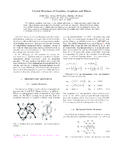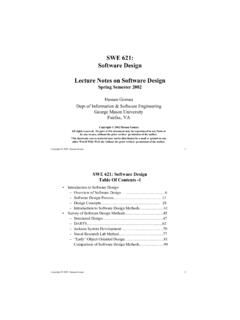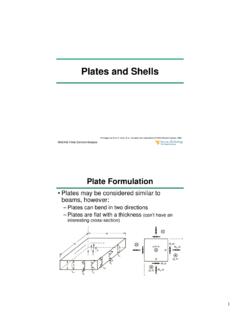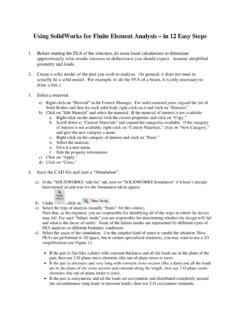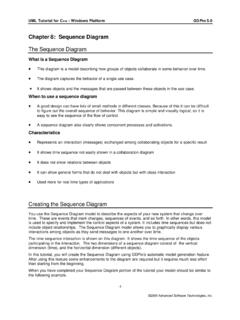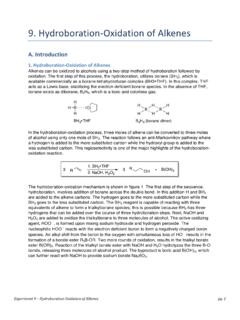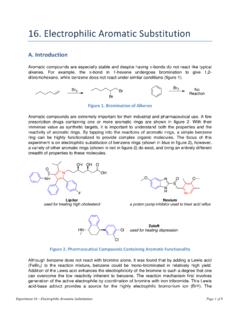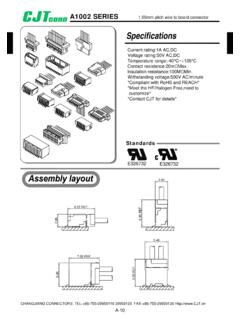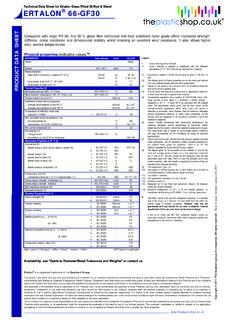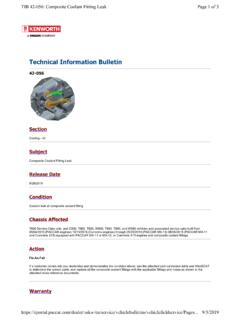Transcription of 15. Synthesis of a Polymer: Nylon-6,6
1 Experiment 15 Synthesis of a Polymer: Nylon-6,6 pg. 1 15. Synthesis of a Polymer: Nylon-6,6 A. Introduction Nylon-6,6 , a synthetic polymer, was synthesized and discovered to have commercial properties in the 1930 s by Wallace Caruthers and co-workers at a DuPont research laboratory. DuPont began the mass production of nylon and their first commercial nylon product, nylon stockings, hit the market in 1940. Since that time, various other forms of nylon , such as nylon -6,10 have been developed. nylon is presently found in numerous commercial products including: clothing, parachutes, ropes, and toothbrush bristles.
2 Additionally, many machined parts, such as the frame of the Glock handgun is made of a nylon composite. Polymers are large (high molecular weight) molecules made by repetitively bonding together many smaller units called monomers as shown in figure 1a. To represent the many units that are present, a single monomer unit is placed in parenthesis with a subscript n to represent some unknown number of units. One of the most commonly encountered polymers is polystyrene (Styrofoam), which is made up of many repeating styrene units as shown in figure1b.
3 In the case of styrene, the monomer units are each joined by new single bonds (in red). Because the styrene double bond took part in the polymerization reaction process, the styrene subunits within the polymer no longer possess the alkene functionality. Figure 1. Polymerization: (a) Generic Example; (b) Polystyrene Polystyrene is considered a chain-growth polymer because it is formed by a chain reaction where some initiator adds to the first molecule of monomer to yield a reactive species which in turn reacts with a second molecule of monomer and so on (figure 2).
4 Also, polystyrene is classified as a homopolymer because it is made up of identical repeating units. Styrene=nPolystyreneMMM-MMM-M-MMM-M-M-MA ddition of many more M unitsMna polymera monomernew bonds between monomer units(a)(b)Experiment 15 Synthesis of a Polymer: Nylon-6,6 pg. 2 Figure 2. Radical Chain Growth Polymerization of Styrene Different from the homopolymers are copolymers. Copolymers are polymers that contain two or more different monomer units embedded within their structure. Copolymers can be either random or alternating as shown in figure 3.
5 Figure 3. Alternating Versus Random Copolymers One of the best-known copolymers is Saran which is commonly used plastic wrap. Saran is prepared by the polymerization of chloroethene and 1,1-dichloroethene. In the Saran polymer, there are four times as many 1,1-dichloroethene units as there are chloroethene units. Modulating the ratio of the two monomers used to form the copolymer will give products with variable properties such as different flexibilities and different tensile strengths. Figure 4.
6 Polymerization of Two Different Monomers to Form the Copolymer Saran nylon 6,6, which you will prepare in today s lab experiment is an example of an alternating copolymer because it contains alternating diamine and dicarbonyl units. The 6,6 numbering refers to the number of carbon atoms in the diamine and dicarbonyl units, respectively. Another frequently encountered synthetic nylon polymer is nylon 6,10. This polymer also has the six-carbon diamine unit, but the dicarbonyl unit contains ten carbon atoms.
7 PhInitiatorI+PhPhPhIPhPhIPhPhIPhAlternat ing CopolymerRandom Copolymer= Monomer Unit 1= Monomer Unit 2 ClClCl+nnClClClSaranNHOHNONHOOHN6 carbon diamine unit6 carbon dicarbonyl unitNylon 6,6 Experiment 15 Synthesis of a Polymer: Nylon-6,6 pg. 3 nylon is characterized differently than the chain growth type polymers discussed above. nylon is considered a step growth polymer. In a step-growth polymer, each bond of the polymer is formed stepwise, independent of the other bonds. In other words, in a chain growth polymerization, each reaction is dependent on the reactive intermediate formed in the previous step, while in a step growth polymer each bond is formed without regard to the other bond forming processes occurring in the mixture.
8 nylon can also be classified as a condensation polymer. Condensation is a reaction in which two molecules are joined together along with the loss of a small molecule such as water. In this lab experiment, you will be adding adipoyl chloride to 1,6-hexanediamine. The acid chloride and amine react and are joined in a condensation process with loss of the small molecule HCl. The product contains a newly formed amide bond (figure 5). The resulting product has both an acid chloride and amine functional group that can react with molecules of 1,6-hexanediamien and adipoyl chloride, respectively.
9 This process continues until all the reagents have reacted to form nylon 6,6 polymer. Figure 5. Formation of the Amide Bond in nylon In the experiment, you will layer a solution of adipoyl chloride in cyclohexane onto an aqueous basic solution of 1,6-hexanediamine (hexamethylenediamine). Because cyclohexane and water are immiscible, a two-layer system will result. The polymerization will take place at the cyclohexane-water interface. Sodium hydroxide is added to the reaction mixture to aid in the amide formation.
10 Figure 6. Formation of nylon 6,6 B. Experimental Procedure Place 10 mL of a 5% solution of adipoyl chloride in cyclohexane in a 50-mL beaker. Place 10 mL of a 5% aqueous solution of hexamethylenediamine in a separate 150-mL beaker. Add 7 drops of 20% sodium hydroxide solution to the hexamethylenediamine solution. Slightly tilt the beaker containing the aqueous diamine solution and carefully pour the adipoyl chloride solution down the wall of the beaker to form two layers. If the solutions are poured together too OOClCladipoyl chloride+NH2N1,6-hexanediamineHH-HClOOCl NH2 NHNewly formed amide bondOOClClNH2 NHHOOHNNHnNylon 6,6incyclohexaneinwater+NaOHformed at liquid interfaceExperiment 15 Synthesis of a Polymer: Nylon-6,6 pg.
